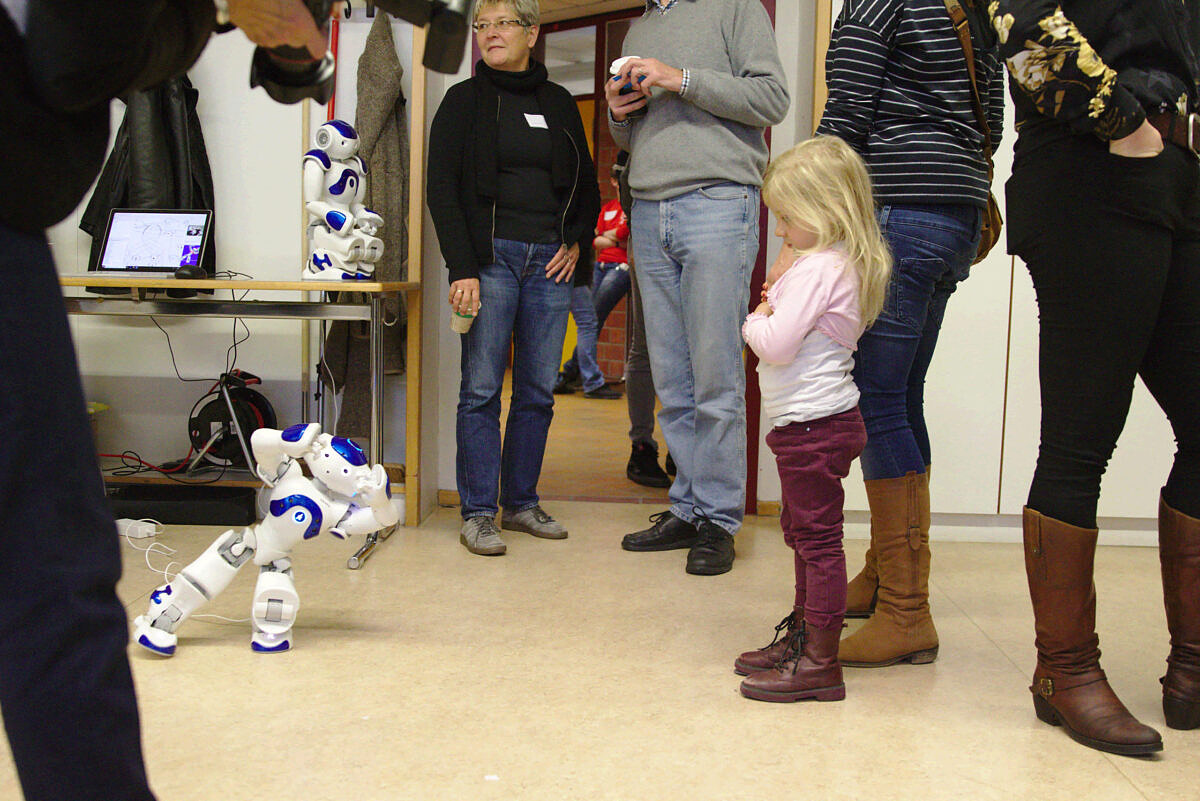Robots as teachers: Can we learn about technology from them as well?
Can you imagine C3PO at the front of the lecture hall? Metal and circuit boards instead of flesh and blood? Although many might see this as a mad prepubescent utopia or plot from a 1980s trash movie, it is already very close to reality.

Reality, but rarely realistic: Robots as teachers
Working with robots is actually a real classroom practice. Or, at least, the idea of using robots as basic technology in schools is nothing new. But the fact that the idea sounds strange to us at first indicates that utilizing the possibilities of technology in the classroom and lecture hall is still some way off. Right now, robots are restricted to demonstrations in subjects like IT and programming.
Just like AI, robotics is a key technology that is helping to revolutionize all areas of everyday life and the economy. But there is still a long way to go until robots are playing the role that is envisioned for them in the schools of the future. Why is that? What are the benefits and opportunities of using robots in education, what are their potential applications, what about the requirements for teaching principles and methods, and will they be accepted by students, teachers, and parents?
Let’s ask someone who should have all the answers. Detlef Steppuhn has spent the last 30 years at the Erich-Gutenberg-Berufskolleg in Cologne, where he teaches courses on e-commerce, office processes, IT systems, application development, and organization theory. He is head of the Media and New Technologies department and author of the book “SmartSchool – Die Schule von morgen” (SmartSchool – The School of the Future). He is no stranger to using robots in his teaching and actively and intensively explores the opportunities that robots offer in education.

What kinds of robots are currently used in schools and what can they actually do?
Detlef Steppuhn: Although robots are already being used in some schools, it is limited to process-based robotics in vocational trade colleges or LEGO robots that are used in IT lessons in many general education schools. We got into robotics quite by chance when we were asked to take part in a competition, the Galeria LEGO Challenge. Integrating this competition into lessons really boosted student motivation and helped them organize themselves and their learning in the classroom, which ultimately resulted in the class that participated winning the competition.

These days, however, I see the use of humanoid robots in education as a particular priority. EGB in Cologne is a vocational college with a commercial focus, and we currently have
- 5 LEGO Mindstorms robots,
- 6 NAO robots, and
- 1 Pepper robot,
and we work hard to integrate these robots into our teaching.
Pepper, NAO, and the rest of the teaching staff
- Pepper (created in 2014) is a humanoid robot that was developed in a partnership between French company Aldebaran Robotics SAS and Japan-based company SoftBank Mobile Corp. Pepper can analyze human facial expressions and gestures, and can respond to human emotions. He is used in education, healthcare, and sales, and to welcome visitors.
- NAO (created in 2006) is another humanoid robot from Aldebaran Robotics SAS. He gained worldwide sporting fame as a result of the RoboCup Games initiative. NAO robots can see, hear, speak, move independently, and touch, so they can actively interact with students. NAO robots are already available on the market for around 5,000 euros.

- LEGO Mindstorms (created in 1998): The product series is based on programmable LEGO building blocks (RCX, NXT, EV3 and, starting in 2020, Robot Inventor Hub No. 13), electric motors, sensors, and LEGO Technic pieces. Students can use these components to build robots and other interactive and autonomous systems. LEGO Mindstorms can also be used in lessons as a practical example of an embedded system.
"It is absolutely clear that using and engaging with robots – and particularly with humanoid robots – during lessons helps students expand their skills, motivates them to a high degree, and they have a lot of fun and enjoy what they are learning."
Humanoid NAO robots are now available for hire – for example from the MINTmacher network operated by Initiative Regionalmanagement Region Ingolstadt e.V – to get students interested in robotics at an early age. Higher up the school, these robots can be used to give practical lessons in Javascript, Java, C++, and Python programming languages.
Robots as teachers in colleges and adult education
“Robotics” is a field that has been part of educational plans for some time now; for example, in the IT classes for gifted students offered at the Hamburg University of Technology (TUHH). So far, attempts to use robots for teaching purposes outside of technical subjects in a higher education setting are extremely rare. Since 2017, Philipps-Universität Marburg has been testing the Pepper and NAO robots as teaching assistants for arts and humanities subjects in a university setting. Systems like those from LEGO Mindstorms can be used to recreate and simulate almost any kind of mechanical installation with embedded systems – from an elevator up to a complex assembly.
What opportunities and challenges are involved in teaching and learning with robots?
Detlef Steppuhn: As Vishal Sikka points out, schools, colleges, and universities around the world teach students what things were, and not what they will be. Education has to adapt to the digital transformation that is currently underway. Labor market studies – the best known are probably the Frey/Osborne and the Delphi studies – indicate that robotics combined with artificial intelligence, big data, and also virtual/augmented reality will change or eliminate many jobs over the next few years.
Using humanoid robots would allow schools to map and familiarize students with part of the digital world of today and tomorrow in a modern and future-oriented way. If students learn and work in dialogue with machines/robots, it should raise their awareness of robotics as a topic. Interacting with humanoid robots will also help students get to know their potential future colleagues and/or competitors better. The challenge is to integrate robots into teaching and learning.
This involves adapting or creating learning situations. Along with artificial intelligence and virtual/augmented reality, robotics is a topic that should be part of every curriculum. Every student must have the opportunity to learn about the digital technologies that are key for the future while they are still in school. But specialized and methodological skills alone will not be enough in the future, and in fact are already not enough in the present –students need to have “digital human skills”. They must be given the opportunity to help shape both their personal and communal social world, both physical and digital, and must be able to live in it with confidence. To accomplish this, they also need a table of values, so that they can assess the opportunities and risks of the digital transformation.
"Students must have the opportunity during their academic and professional education to familiarize themselves with the topic, and to gain more than a basic knowledge of programming and robotics. In terms of education policy, the question would be whether programming should become the first or second language of the future."
Will robots replace teachers in the future?
Detlef Steppuhn: Introducing robotics and artificial intelligence as key digital technologies in the future could lead to a complete redesign of the teaching profession, and of teacher training and continuing professional development. Humanoid robots could develop into personal teaching assistants, which would turn teachers into coaches or learning guides. This would free up a lot of teaching time, which could be used extremely effectively to provide one-to-one coaching.
From a neuroeducation perspective, the social relationship between students and teachers is an essential factor in the learning process, because our brains are programmed to be social. Students learn more effectively if social interactions are incorporated into the learning process. In other words, the social relationship between students and teachers is one of the key factors for successful learning; if this relationship is absent, even highly skilled teachers with methodological expertise will not succeed. Positive relationships strengthen the learning process.
But this key factor is also a significant risk. If negative social relationships are established, they rarely result in successful learning – as we can probably all agree on based on our own school experiences. A potential alternative when social relationships have negative connotations would be to use humanoid robots as digital learning assistants. Research shows that children and young people are very receptive to humanoid robots, and even develop a form of empathy for them.
Robots in education: more insights and experiences
You can read the full interview with Detlef Steppuhn in our “Digital education” e-book, which takes a practical approach. Speaking from his own experience, Detlef talks about what is involved in using robots in education and what his experiences to date have taught him about the opportunities and challenges of teaching and learning with robots. Download your “Digital education” e-book here now.






